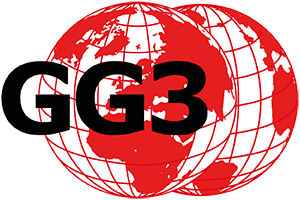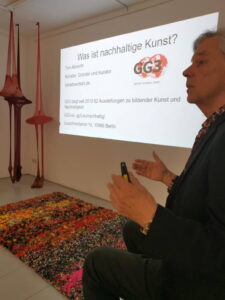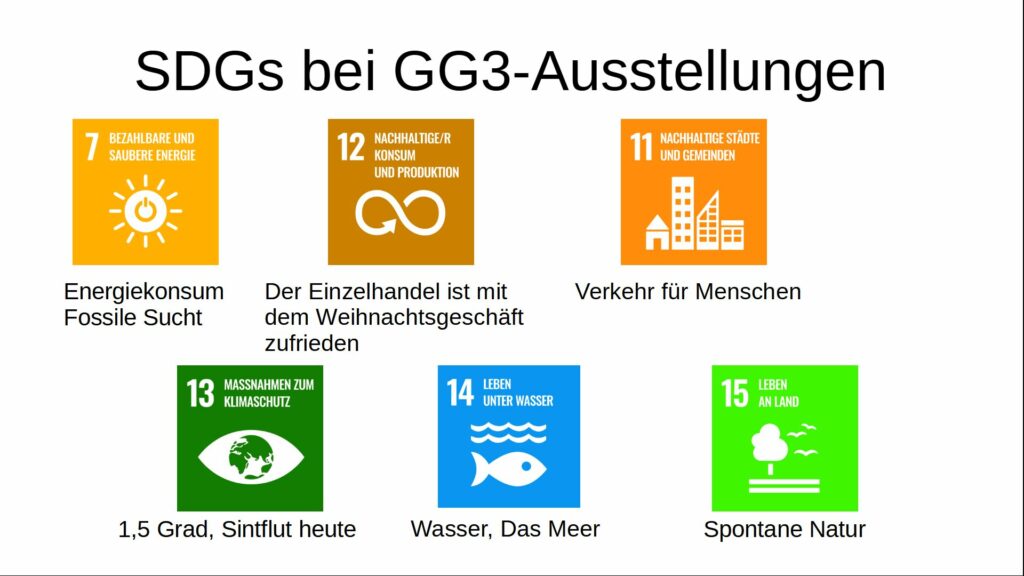Lecture by Tom Albrecht with workshop for guests and artists Fri, 3.11.2023 as part of the exhibition “Light-footed, 10 years of sustainability art”
What is sustainable art?
Tom Albrecht
Artist, founder and curator
tomalbrechtart.de
GG3 has shown 62 exhibitions on visual arts and sustainability since 2013
GG3.eu, gg3.eu/sustainable/
Leuschnerdamm 19, 10999 Berlin
Motifs for sustainable art
Climate change and species extinction are major social challenges, locally, nationally and globally
The linear dialog between the press and science is reaching its limits
Art as a source of social impetus
Art can touch, stimulate the imagination, move solutions through associations
Market niche, “First come, first served.”
Voluntary process. Reasons can be concerns about the world, passing on experiences, influencing society
Sustainable art
is art that practices sustainability in theme, material and place, because of its consistency and credibility, reduces its own ecological footprint
Works for the largest possible ecological handprint with a major impact on society, is low-barrier, dialogical,
uses exhibitions, website, mailing, press
“Do good and talk about it”
Economical, social and ecological
The three belong together for sustainability.
Germany has the greatest ecological deficits: Climate protection, species extinction.
In international comparison, Germany is considered to be a largely functioning state in economic and social terms.
Solving deficits with a focus on the ecological, combined with the social and economic.
Sustainable art is political
In the tradition of John Heartfield, founder of political photomontage, Otto Dix anti-war glorifying, Picasso Guernica complaining against war and destruction, Joseph Beuys worthy of criticism, but 7000 oaks a sign against the destruction of nature, Berlin Ben Wargin e.g. Parliament of Trees
Sustainability is currently struggling behind wars and the pandemic.
Sustainable art supports the 17 Sustainable Development Goals as political objectives of the United Nations (UN), which are intended to ensure sustainable development on an economic, social and ecological level worldwide.
SDGs at GG3 exhibitions
Four areas belong together
Operation of the art venue e.g. reduce CO² product
Artists in material, theme, their business
Theme of the exhibitions, the works
Publicity for guests, advertising
1. operation of the art venue
Founding a Green Team, formulating a mission statement
Record consumption values
Potential electricity savings for lighting and appliances? Lighting concept
Heating the exhibition and work rooms: shock ventilation, room temperature
Print jobs e.g. RC paper
Waste separation, waste avoidance
Ecological service provider: catering, provider, bank
Reuse packaging
Tea kitchen Coffee machine
1st operation: Networking
Gallery Climate Coalition (GCC) is an international non-profit community of arts organizations committed to reducing the environmental impact of their sector.
The GCC’s primary goal is to reduce its CO 2 emissions by at least 50% by 2030 and to promote zero waste.
Members are artists, commercial and non-commercial art institutions.
Offer CO2 calculator, best practice guidelines, campaigns
“Sustainability Action Network” Focus on operational ecology, trains consultants, certificate, e.g. museums with air conditioning, theaters
Offers from GG3 on gg3.eu under “Gallery”, “Sustainable”: Mission statement,
Sustainability check for project spaces, Sustainability as a theme for works and exhibitions, Sustainability for visual artists, Sustainability for commercial galleries
2. artists:inside
Encourage the use of sustainable materials as a gallery
E.g. exhibition “Light-footed” has as a condition
the small ecol. Footprint of the plant
Express a wish to use NH material
gg3.eu/sustainability-for-educating-artists/
HDM, Kunststoffe e.V.
Mail instead of travel
Arrival e.g. by train instead of flight
3. Sustainable Art
creates images for the abstract
Wants to change, gets involved
can help to encourage movement
seeks topicality
addresses problems
Picking up where science ends
Dystopian with a window of hope
Art venue: gallery, project space, museum, studio, collection, outdoors
3. sustainability in the topic
From current social discussion
Works e.g. Thomas Behling “Map of Berlin” (detail)
GG3 exhibitions:
after the catastrophe in the Ahr valley: “Flood today”
“Farmer seeks industry” species extinction
“Cargo” transport for goods, delivery services
“Light on its feet” small ecol. Footprint of the works
4. public
People are looking for answers to the crises
A chance for the art of touching, credible
Inform guests about public transport connections
Join GCC
Present your own commitment in the four areas on your own website
Advertise on sustainable websites
e.g. gemeinschaftswerk-nachhaltigkeit.de
GG3 has resonance: Radioeins, Creative City Berlin, Art next Door, Prolog, RBB Kultur, Senate Prize, TAZ, bpigs, 1000 Interwievs, coinspiration, Zeitschrift für Kultur
Movement for more sustainability in art venues
Big places like museums are starting to move. Energy costs, support from the federal government, sustainability action network, e.g. energy consulting for theaters
Municipal Galleries Berlin: AK organized conference on NH 2022
Project spaces Berlin hardly any resonance, offer AG sustainability. Prize money from the cultural senate is missing
Commercial galleries in Berlin: 2022 competition by the Senate of Economics, varying degrees of commitment
Art colleges: KH Weissensee has NH mission statement, Berin University of the Arts: climate protection concept for operations and teaching
The process is too slow. The focus is on operations.
Workshop
Problem bubble: How can sustainable art generate more impact?


